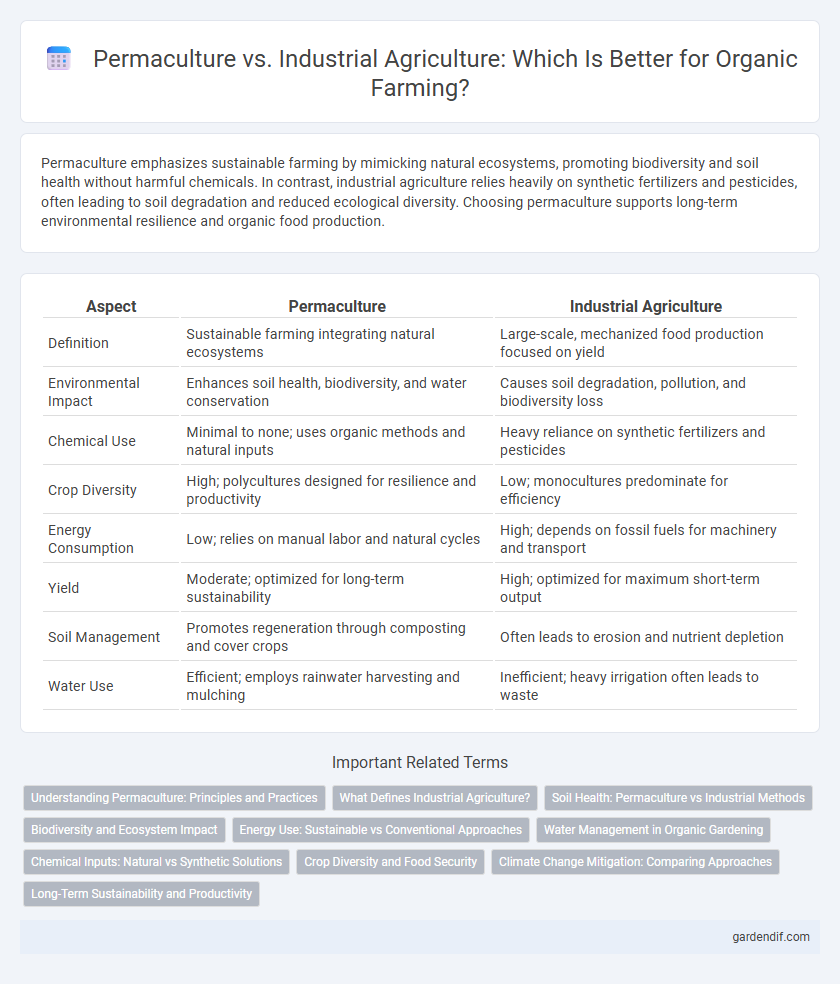
Permaculture vs industrial agriculture Illustration
Permaculture emphasizes sustainable farming by mimicking natural ecosystems, promoting biodiversity and soil health without harmful chemicals. In contrast, industrial agriculture relies heavily on synthetic fertilizers and pesticides, often leading to soil degradation and reduced ecological diversity. Choosing permaculture supports long-term environmental resilience and organic food production.
Table of Comparison
| Aspect | Permaculture | Industrial Agriculture |
|---|---|---|
| Definition | Sustainable farming integrating natural ecosystems | Large-scale, mechanized food production focused on yield |
| Environmental Impact | Enhances soil health, biodiversity, and water conservation | Causes soil degradation, pollution, and biodiversity loss |
| Chemical Use | Minimal to none; uses organic methods and natural inputs | Heavy reliance on synthetic fertilizers and pesticides |
| Crop Diversity | High; polycultures designed for resilience and productivity | Low; monocultures predominate for efficiency |
| Energy Consumption | Low; relies on manual labor and natural cycles | High; depends on fossil fuels for machinery and transport |
| Yield | Moderate; optimized for long-term sustainability | High; optimized for maximum short-term output |
| Soil Management | Promotes regeneration through composting and cover crops | Often leads to erosion and nutrient depletion |
| Water Use | Efficient; employs rainwater harvesting and mulching | Inefficient; heavy irrigation often leads to waste |
Understanding Permaculture: Principles and Practices
Permaculture emphasizes sustainable land use based on ecological principles, promoting biodiversity, soil health, and water conservation through techniques like companion planting, mulching, and rainwater harvesting. Unlike industrial agriculture, which relies heavily on synthetic fertilizers and monoculture, permaculture integrates natural cycles and renewable resources to create resilient agricultural ecosystems. Core principles include observing natural patterns, minimizing waste, and designing for energy efficiency to foster long-term environmental and economic sustainability.
What Defines Industrial Agriculture?
Industrial agriculture is defined by large-scale monoculture production, heavy reliance on synthetic fertilizers, pesticides, and mechanized equipment to maximize crop yields and efficiency. It emphasizes high input-output systems, often resulting in soil degradation, reduced biodiversity, and increased greenhouse gas emissions. The focus is on maximizing short-term productivity and profit, often at the expense of environmental sustainability and long-term soil health.
Soil Health: Permaculture vs Industrial Methods
Permaculture enhances soil health by promoting biodiversity, using cover crops, and applying organic mulches that improve soil structure and nutrient cycling. Industrial agriculture often relies on synthetic fertilizers and chemical pesticides, leading to soil degradation, reduced microbial activity, and erosion. Sustainable permaculture practices restore soil fertility naturally, supporting long-term ecosystem resilience and productivity.
Biodiversity and Ecosystem Impact
Permaculture enhances biodiversity by mimicking natural ecosystems, promoting soil health, and supporting a wide range of plant and animal species, while industrial agriculture often relies on monocultures that reduce habitat variety and soil quality. The diverse planting strategies in permaculture create resilient ecosystems with improved pest control and nutrient cycling compared to the chemical-dependent practices of industrial farming. Sustainable permaculture systems contribute to carbon sequestration and water retention, mitigating environmental degradation linked to industrial agriculture.
Energy Use: Sustainable vs Conventional Approaches
Permaculture minimizes energy use by relying on natural processes, renewable resources, and manual labor, significantly reducing fossil fuel dependence compared to industrial agriculture, which heavily consumes energy through machinery, synthetic fertilizers, and pesticides. Sustainable permaculture aligns with ecological principles to optimize energy efficiency and carbon sequestration, whereas conventional approaches generate higher greenhouse gas emissions due to intensive mechanization and agrochemical inputs. Studies reveal that permaculture systems can reduce energy inputs by up to 90%, promoting long-term soil health and biodiversity while industrial agriculture often leads to energy-intensive monocultures with greater environmental degradation.
Water Management in Organic Gardening
Permaculture prioritizes water conservation through techniques like rainwater harvesting, swales, and mulching, which enhance soil moisture retention and reduce runoff. Industrial agriculture often relies on intensive irrigation systems that can deplete groundwater and contribute to soil erosion. Organic gardening within permaculture frameworks promotes sustainable water cycles by integrating natural landscapes and minimizing water waste.
Chemical Inputs: Natural vs Synthetic Solutions
Permaculture relies on natural solutions such as compost, green manure, and biological pest control to enhance soil fertility and plant health, minimizing chemical inputs. Industrial agriculture depends heavily on synthetic fertilizers, pesticides, and herbicides to maximize crop yields and control pests, often leading to soil degradation and environmental pollution. The contrast between chemical inputs highlights permaculture's emphasis on sustainability and ecosystem balance versus industrial agriculture's focus on productivity and efficiency.
Crop Diversity and Food Security
Permaculture emphasizes crop diversity through polycultures, which enhance soil health, reduce pest outbreaks, and increase resilience against climate variability. In contrast, industrial agriculture relies heavily on monocultures, making food systems more vulnerable to pests, diseases, and environmental shocks. Greater crop diversity in permaculture contributes directly to improved food security by ensuring a steady supply of varied nutrients and reducing dependency on single crop yields.
Climate Change Mitigation: Comparing Approaches
Permaculture utilizes diverse, regenerative planting techniques that enhance soil carbon sequestration and reduce greenhouse gas emissions, whereas industrial agriculture often relies on monocultures and synthetic fertilizers, contributing significantly to climate change. Permaculture systems promote biodiversity and water conservation, improving ecosystem resilience to climate variability. Industrial methods typically result in higher carbon footprints due to mechanized operations and intensive resource use.
Long-Term Sustainability and Productivity
Permaculture emphasizes ecosystem health and biodiversity, promoting long-term sustainability through soil regeneration, water conservation, and reduced reliance on synthetic inputs. Industrial agriculture prioritizes high short-term yields but often depletes soil nutrients and increases environmental degradation, compromising future productivity. Integrating permaculture principles can enhance resilience and maintain productivity across multiple growing seasons.
Permaculture vs industrial agriculture Infographic

 gardendif.com
gardendif.com